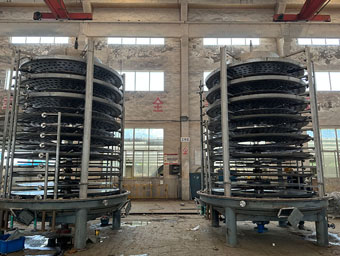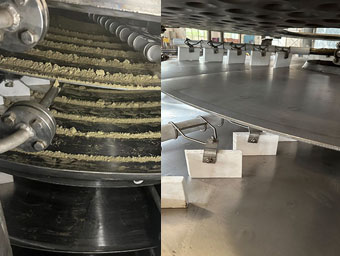telephone:
86-13348188665
Disc dryer is a common industrial drying equipment. The following is a detailed introduction to it:
First, the working principle
The working principle of the disc dryer is based on the fact that wet materials are continuously added to the upper drying disc of the dryer through the feeder. Through the rotary motion of the rake arm and the rake blade, the material flows over the surface of the drying disk along the exponential spiral line. The material is transferred to the outer edge on the small drying tray, and falls to the outer edge of the big drying tray below, moves inward on the big drying tray, and falls into the next small drying tray from the middle blanking port. This alternating arrangement of drying trays enables the materials to continuously flow through the whole dryer. Heating medium, such as saturated steam, hot water or heat transfer oil, is introduced into the hollow drying tray to achieve the purpose of drying. The dried material falls from the last drying tray to the bottom of the shell, and is transferred to the discharge port by the rake blade for discharge. The moisture escapes from the material and is discharged through the moisture outlet on the top cover. For the vacuum disc dryer, the moisture is discharged through the vacuum pump outlet on the top cover.

Second, the structural characteristics
The disc dryer is composed of several hollow discs (also known as loading discs and drying discs) with a certain distance up and down in the shell, and heating media (hot water, steam, heat transfer oil, etc.) are introduced into the discs. The diameters of the upper and lower adjacent disks are different, and the inclination angles can also be different (a large disk can have a high periphery and a low center; The small disc can be high in the center and low in the periphery). The center of the disc dryer is provided with a rotating central shaft (rake shaft) which runs straight up and down, and a plurality of rake arms are installed on the shaft, and each rake arm is provided with a plurality of rake blades or grinders (used for conveying and turning materials and making the materials move along the archimedean spiral trajectory). The distance between the lower end of the rake blade or grinding wheel and the disc, the rotation speed of the central rake shaft, the type and angle of the rake blade, etc. can be optimized according to the material characteristics.
Third, the application field
Disc dryer has the characteristics of simple structure, convenient operation and high drying efficiency, and is widely used in the following fields:
Chemical industry: Disc dryer can be used in the dehydration process of various chemicals, such as dyes and pigments.
Food industry: used for food drying process, such as vegetable drying, fruit chip production, etc.
Pharmaceutical industry: Disc dryer is often used in the drying process of medicinal materials, which can realize the stability and efficacy maintenance of drugs.
Agricultural field: drying is often used in agricultural products processing, and the use of disc dryer can improve the added value and preservation of agricultural products.
Other fields: In addition, the disc dryer can also play an important role in building materials, metallurgy and other fields.
Fourth, performance advantages
High thermal efficiency: heat transfer oil is used to heat evenly and improve drying speed.
Low energy consumption: through optimized design and precise control, energy consumption is reduced and energy utilization rate is improved.
Easy control: according to the material characteristics and drying requirements, the parameters such as the type, angle and speed of the rake blade can be adjusted to achieve accurate control.
Strong applicability: it is suitable for a variety of materials and drying processes and has a wide range of applicability.
Simple operation: the equipment has compact structure, simple and convenient operation and easy maintenance.

V. Performance parameters
The performance parameters of the disc dryer vary with the model and specification. The following are some common performance parameters:
Disc diameter: The disc diameter varies according to different equipment models. Common disc diameters are Ф1400, Ф1500 and Ф1700.
Heat transfer area: According to different equipment models and specifications, the heat transfer area is also different. Common heat transfer areas are 55m², 80m² and 154m².
Spindle speed: Spindle speed can be adjusted according to material characteristics and drying requirements, and the common speed range is 3.8~14.8r/min.
Processing capacity: The processing capacity varies with the model and specification of the equipment, and the common processing capacities are 30T/d, 60T/d and 100T/d, etc.
To sum up, the disc dryer is an efficient, energy-saving and easy-to-control drying equipment, which has a wide range of applications and significant performance advantages. When selecting and using the disc dryer, the reasonable selection should be made according to the material characteristics and drying requirements, and the operation and maintenance should be carried out in strict accordance with the operating rules.